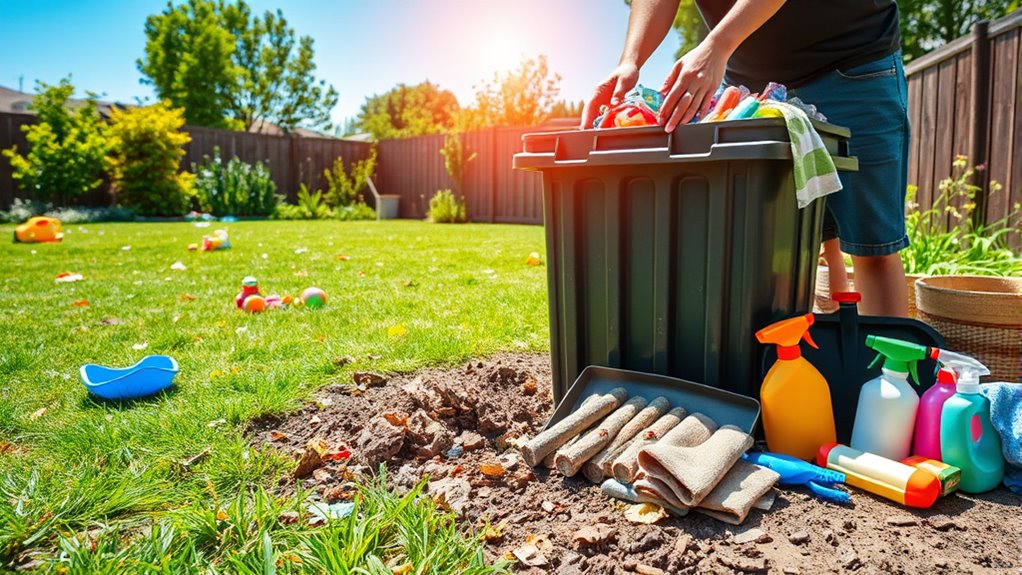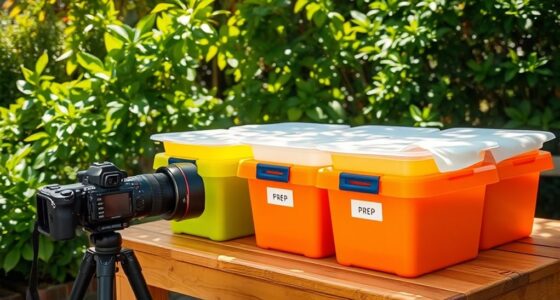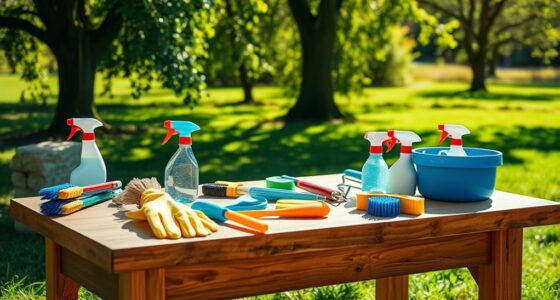To keep your outdoor space safe and inviting, start by evaluating what needs attention, then gather and check your tools and supplies. Clear debris, toys, and other clutter regularly and manage soil, mud, and wet areas with proper drainage and maintenance. Sanitize surfaces often and restock supplies as needed. Maintain the area by trimming, inspecting lighting, and organizing storage, ensuring a tidy environment. Following these steps will help you create a well-kept outdoor playground—more tips await if you continue exploring.
Key Takeaways
- Conduct a thorough site assessment to identify wildlife signs, weather damage, and safety concerns before planning cleanup steps.
- Gather, inspect, and maintain all tools and supplies to ensure safety, functionality, and organized storage for efficient cleanup.
- Clear play areas of debris, toys, and clutter, managing soil and mud issues to promote safety and cleanliness.
- Sanitize surfaces, restock supplies, and organize toys and equipment for hygiene and quick access.
- Perform regular maintenance, safety checks, and content management to sustain a safe, inviting outdoor environment.
Assessing the Mess: What Needs Attention
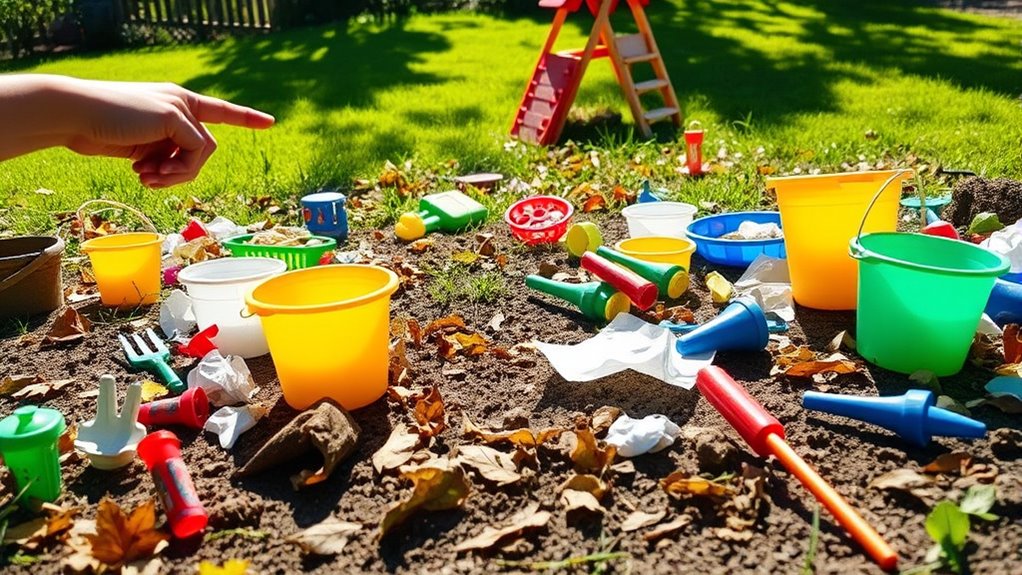
Before you plunge into cleaning, it’s important to assess the mess and determine what needs attention. Start by inspecting your outdoor space carefully. Wildlife intrusion might have left behind nests, droppings, or chewed plants, signaling areas that require removal or repair. Weather impact can also cause damage—fallen branches, muddy patches, or broken furniture. Take note of these issues and prioritize based on severity and safety. Look for signs of wear caused by rain, wind, or storms, which could worsen if ignored. Identifying these problems early helps you plan your cleanup efficiently. By understanding the extent of wildlife intrusion and weather-related damage, you can target your efforts precisely, making the entire cleanup process more effective and less overwhelming.
Gathering Your Cleanup Tools and Supplies
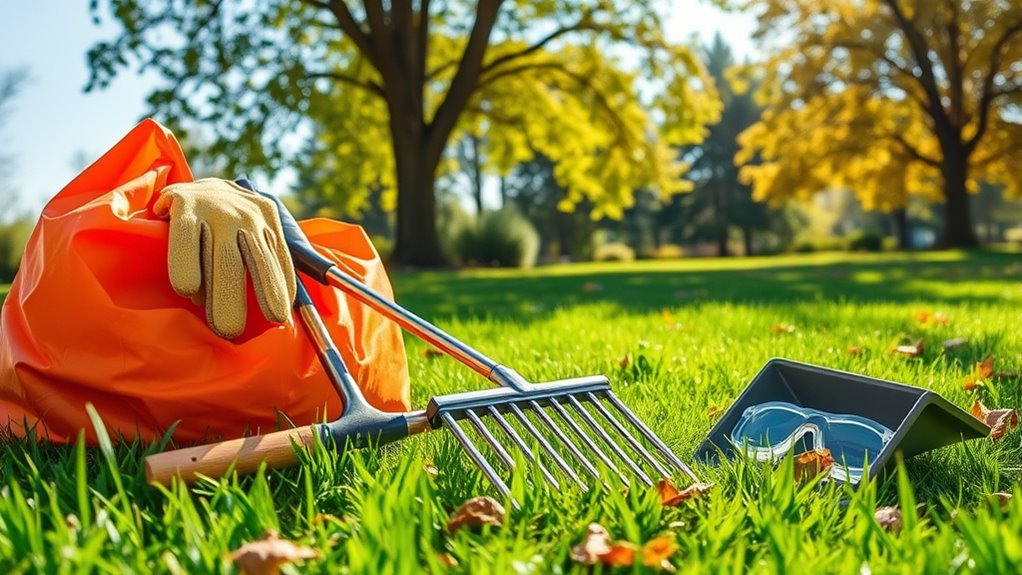
Before you start cleaning, gather all your essential cleanup gear and supplies so you’re ready to go. Make sure your tools are stored in easy-to-access solutions to save time and effort. Check that all your equipment functions properly to avoid surprises during the cleanup process. Incorporating organized storage solutions can streamline your workflow and ensure everything is readily available when needed.
Essential Cleanup Gear
Having the right cleanup gear ready guarantees you can tackle outdoor messes efficiently. Proper outdoor equipment ensures you’re prepared for various situations, from mud to debris. Essential tools include gloves, trash bags, and waste disposal supplies to manage waste responsibly. Investing in durable gear helps prevent delays and makes cleanup smoother. Keep these items organized and accessible so you’re always ready to act quickly. Here’s a quick guide to what you need:
| Gear Type | Purpose | Key Features |
|---|---|---|
| Trash bags & bins | Waste disposal | Heavy-duty, leak-proof |
| Gloves | Protect hands | Waterproof, comfortable |
| Cleaning tools | Surface cleanup | Brooms, brushes, cloths |
This gear empowers you to handle outdoor messes confidently and responsibly.
Additionally, considering dog breeds with friendly and adaptable temperaments can be beneficial when planning outdoor activities or cleanup routines, ensuring a harmonious environment for all involved.
Supply Storage Solutions
Organizing your cleanup tools and supplies guarantees you can quickly access what you need when outdoor messes happen. Using outdoor storage solutions keeps everything neat and protected from the elements. To streamline your process, consider these steps: 1. Choose weather-resistant bins or cabinets for toys and tools, ensuring durability and easy access. 2. Designate specific areas for toy organization, like shelves or bins, so toys are easy to find and put away. 3. Keep frequently used supplies close by, such as spray bottles, cloths, and trash bags, in portable caddies or hooks. Additionally, selecting safe and durable storage options helps prevent accidents and prolongs the lifespan of your outdoor equipment.
Checking Equipment Functionality
Regularly checking your cleanup tools and supplies guarantees everything works properly when you need it. Start with an equipment inspection to identify any damage or wear that could hinder performance. Ensure brushes, brooms, and dustpans are intact and functional. Perform safety checks on equipment like leaf blowers or power washers, verifying cords, switches, and safety guards are in place. Replace worn-out or broken tools promptly to prevent accidents or incomplete cleanup. Confirm that cleaning solutions and supplies are stored correctly and aren’t expired. Keeping your tools in good condition saves you time and effort, and it helps maintain a safe outdoor environment. Incorporating tuning upgrades can also help improve the efficiency of your outdoor equipment by optimizing performance and fuel consumption. Taking a few minutes for these inspections guarantees your cleanup process is efficient, safe, and ready to go whenever you need it.
Clearing Play Areas and Removing Toys
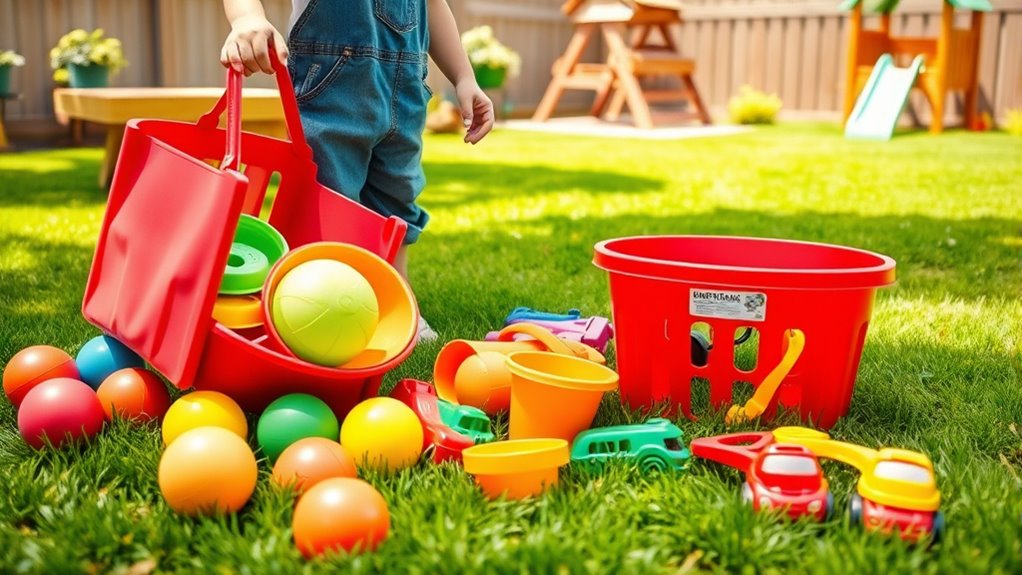
To keep play areas safe and inviting, start by clearing away any clutter and removing toys that are no longer in use. Proper toy organization helps prevent accidents and makes outdoor safety easier to maintain. Focus on these steps:
- Gather all toys scattered around the area and sort them by size and type.
- Discard broken or worn-out toys that no longer serve a purpose.
- Store frequently used toys in accessible bins or shelves for easy access and neatness.
- Incorporate mental clarity techniques to stay focused during cleanup and organization efforts.
Managing Soil, Mud, and Debris
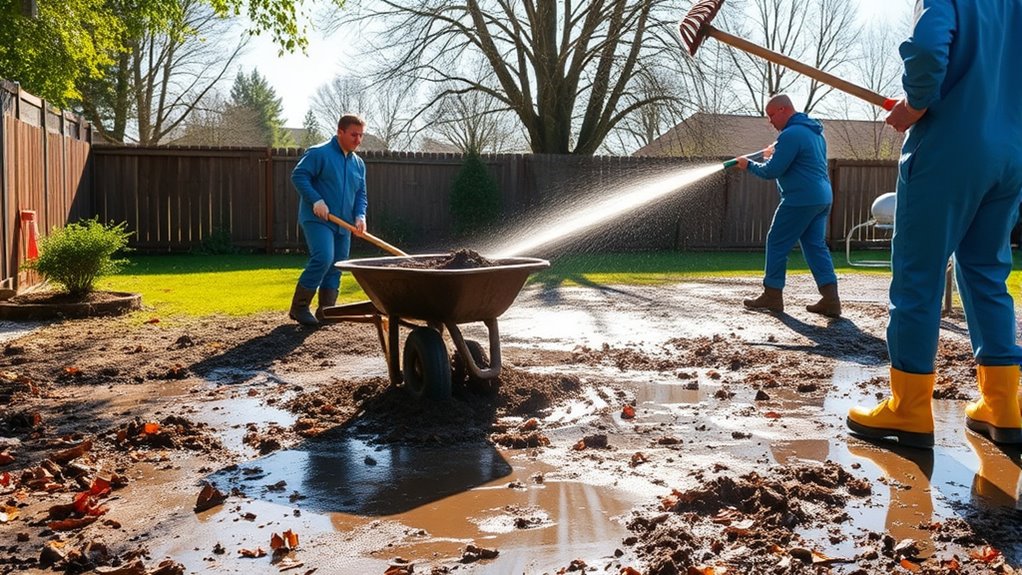
Managing soil, mud, and debris is essential for keeping outdoor play areas safe and clean. You’ll want effective soil removal techniques, practical mud management strategies, and simple debris disposal tips. Let’s explore how to handle each of these to maintain a tidy, enjoyable space. Incorporating regular maintenance routines can prevent the buildup of grime and ensure a safer environment for children.
Soil Removal Techniques
Effective soil removal is essential to maintaining a clean outdoor play area, especially after heavy rains or prolonged use. To do this effectively, you need targeted techniques that address soil compaction and nutrient imbalance. First, aerate the soil to loosen compacted layers, making debris removal easier. Second, perform a nutrient analysis to identify deficiencies, ensuring the soil’s health isn’t compromised during cleanup. Third, use a shovel or tiller to carefully extract compacted soil and debris, minimizing disruption to the surrounding area. Proper removal not only clears the surface but also prepares the soil for future improvements. Additionally, incorporating soil tuning techniques can help optimize soil conditions for better drainage and plant growth. By focusing on these techniques, you ensure a safer, more inviting play zone that promotes healthy soil conditions and reduces future maintenance.
Mud Management Strategies
After removing soil and debris, controlling mud and wet conditions becomes the next priority to keep your outdoor play area safe and usable. To manage muddy footprints, set up gravel or stepping stones in high-traffic areas to reduce tracking mud into play zones. Encourage kids to wipe their shoes before entering and provide designated muddy zones with easy drainage. Keep wet clothing manageable by having dry, accessible storage or hooks nearby, so kids can change quickly if they get soaked. Use barriers or mats at entry points to catch excess mud and prevent spreading. Regularly raking or aerating muddy patches helps improve drainage and dries the ground faster. Incorporating creativity into your cleanup routines, such as involving children in the process, can make the task more engaging and effective. These strategies minimize the mess, reduce slipping hazards, and keep the area safer for everyone.
Debris Disposal Tips
To keep your outdoor play area clean and safe, it’s essential to have a plan for disposing of soil, mud, and debris efficiently. First, gather fallen leaves through regular leaf collection, preventing buildup that can hide hazards. Second, position trash bins strategically, ensuring they’re accessible for quick debris disposal without creating clutter. Third, when managing soil and mud, use sturdy containers or a designated area for removal, making cleanup easier. Always keep trash bin placement clear of play zones to avoid accidents. Regularly empty bins to prevent overflow and reduce odors. Additionally, understanding the importance of content ownership rights can influence how you manage and share your outdoor space. By staying proactive with leaf collection, bin placement, and debris management, you’ll maintain a safe, tidy outdoor space for play and fun.
Sanitizing and Disinfecting Surfaces
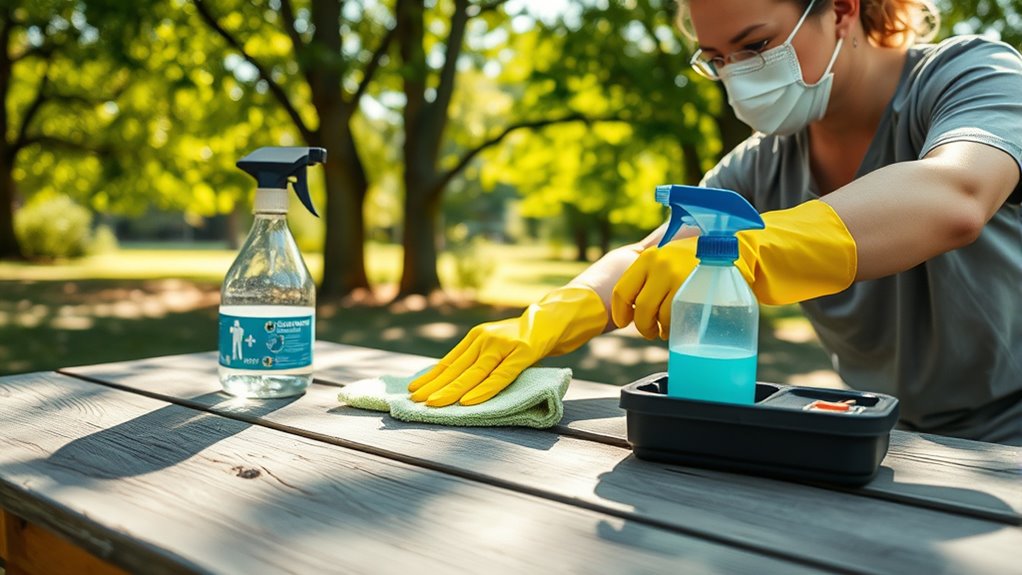
Sanitizing and disinfecting surfaces is a crucial step in keeping outdoor play areas safe for children. Surface contamination can harbor germs and bacteria, increasing health risks. To effectively reduce this, you need to use proper disinfection methods. Start by cleaning surfaces with soap and water to remove dirt and debris, which can hinder disinfectant effectiveness. Then, apply an EPA-approved disinfectant suitable for outdoor use, ensuring even coverage. Pay close attention to high-touch areas like swings, slides, and benches. Follow the manufacturer’s instructions for contact time to ensure proper disinfection. Regular sanitizing not only minimizes the spread of germs but also prolongs the lifespan of play equipment. Consistent cleaning creates a safer environment where children can play freely without unnecessary health concerns. Incorporating professional cleaning services can further enhance the safety and thoroughness of outdoor sanitation routines.
Restocking and Organizing for Next Time
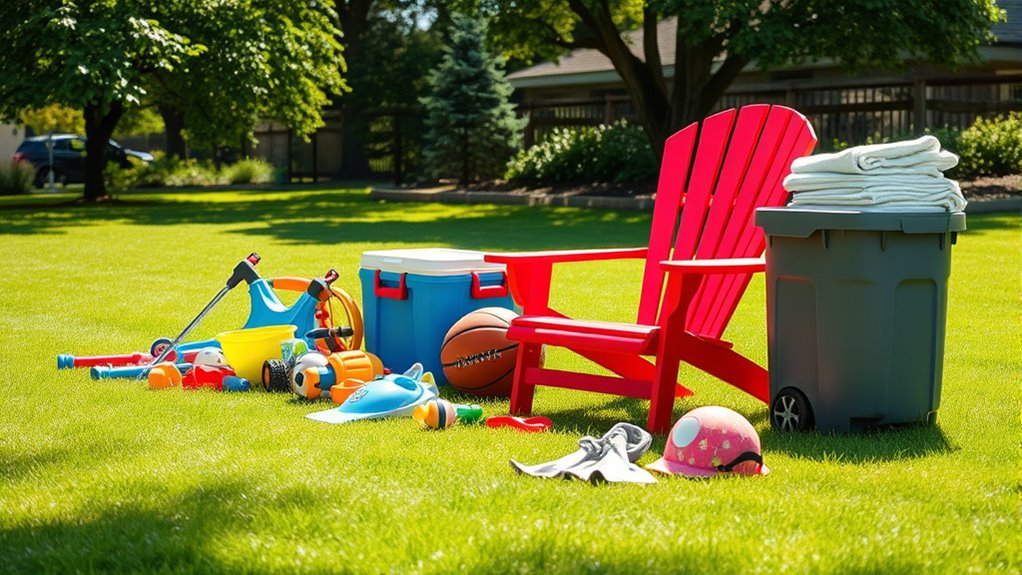
Have you ever finished cleaning outdoor play areas and wondered if everything’s ready for the next session? Restocking and organizing are key to a smooth setup. First, check your toy organization: ensure all toys are clean, functional, and sorted by type. Second, replenish supplies: restock items like bubbles, chalk, or snacks to prevent shortages. Third, tidy storage: return toys and equipment to their designated spots, making future cleanup easier. Clear labels help you quickly identify where everything belongs. Keep an inventory list to track what needs replacing or adding. Taking these steps ensures your outdoor space stays inviting and ready for fun, without last-minute chaos. Proper organization and supply replenishment save time and keep play areas safe and enjoyable.
Tips for Maintaining a Tidy Outdoor Space
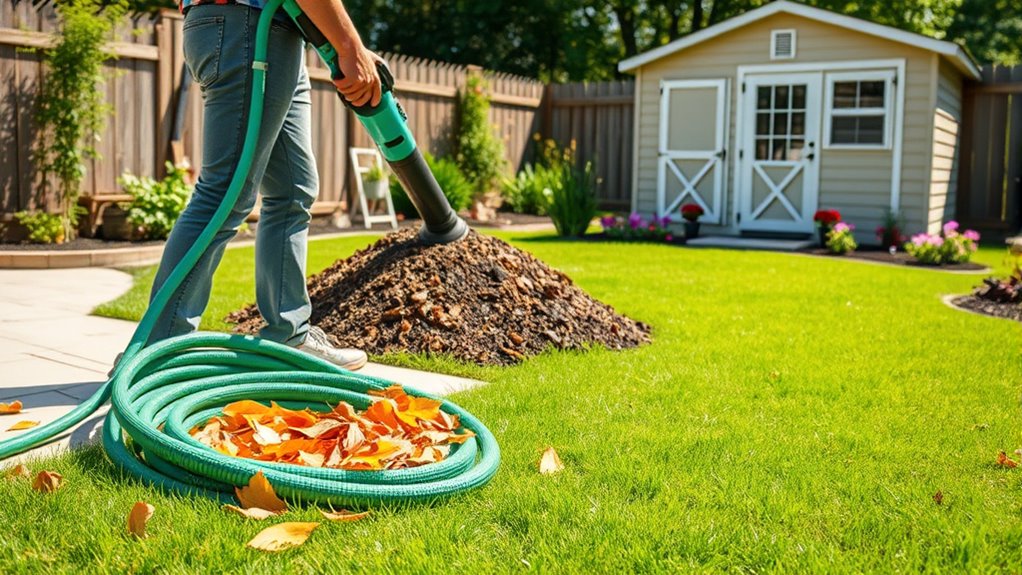
Maintaining a tidy outdoor space is an ongoing effort that keeps play areas safe and inviting. Focus on regular upkeep, like trimming bushes and picking up debris, to prevent clutter. Incorporate smart landscape design by planting low-maintenance greenery and creating designated zones for play and relaxation. Proper outdoor lighting extends usability and enhances safety during evening hours. Use the table below to plan your maintenance tasks:
| Task | Frequency | Tips |
|---|---|---|
| Lawn Care | Weekly | Mow, water, and aerate |
| Debris Removal | Daily/After storms | Clear fallen leaves and trash |
| Lighting Checks | Monthly | Replace bulbs and adjust fixtures |
Frequently Asked Questions
How Often Should I Perform Outdoor Cleanup Sessions?
You should perform outdoor cleanup sessions seasonally, ideally in spring and fall, to keep your space tidy and safe. Regular maintenance prevents buildup and damage, so adapt your schedule based on local conditions and plant growth. Use proper tool selection for each task, like rakes, pruners, or leaf blowers, to make cleanup efficient. Consistent seasonal maintenance helps maintain a healthy, attractive outdoor environment year-round.
What Safety Precautions Are Recommended During Cleanup?
You absolutely must prioritize safety during cleanup; otherwise, you risk facing hazards that could be catastrophic. Always wear protective gear like gloves, goggles, and masks to shield yourself from dangerous debris and chemicals. Conduct hazard identification prior to starting, spotting potential risks such as sharp objects or unstable surfaces. Staying vigilant and prepared ensures you stay safe and avoid accidents, turning your cleanup session into a smooth, worry-free operation.
Can Eco-Friendly Cleaning Products Be Effective Outdoors?
Yes, eco-friendly cleaning products can be effective outdoors. You should look for biodegradable solutions and natural disinfectants, which break down safely in the environment without leaving harmful residues. These products are often just as powerful as traditional cleaners, especially for routine maintenance and light messes. By choosing natural disinfectants, you can clean effectively while protecting plant life, wildlife, and water quality, making your outdoor cleanup both safe and sustainable.
How Do I Prevent Future Messes in Play Areas?
To prevent future messes in play areas, prioritize regular playground maintenance and establish outdoor storage solutions for toys and supplies. You should schedule consistent inspections to catch issues early, and organize storage bins to keep items off the ground. Encourage kids to clean up after themselves and set clear boundaries for play. These steps help maintain a tidy environment, reduce clutter, and promote safe, enjoyable outdoor play for everyone.
What Are Some Quick Fixes for Common Outdoor Stains?
Did you know that grass stains can take up to a week to fade naturally? For quick cleaning, act fast with stain removal methods like blotting with a mixture of dish soap and water. For common outdoor stains like mud or food, use a scrub brush and a gentle cleaner. Quick fixes prevent stains from setting, making stain removal easier and saving you time on outdoor cleanup.
Conclusion
Keeping your outdoor play area clean is crucial for safety and fun. Did you know that regular outdoor cleaning can reduce bacteria by up to 80%? By following this cleanup workflow, you guarantee a healthier, more enjoyable space for kids to play. Stay consistent with your maintenance, and you’ll create a safe environment where children can explore and grow without worry. A tidy yard isn’t just appealing—it’s essential for their well-being.
